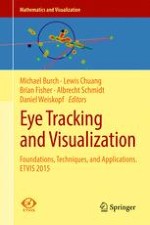
a flashy company label) as well as top-down attention driven searches (e.g. TTFF can indicate both bottom-up stimulus-driven searches (e.g. The Time to First Fixation (TTFF) indicates the amount of time that it takes a respondent (or all respondents on average) to look at a specific AOI from stimulus onset. These metrics come in handy when evaluating the performance of two or more areas in the same video, picture, website, or program interface. You will then be able to display metrics for each region separately, such as how much time passed from stimulus onset until participants looked at the region, how much time your respondents spent in the region, how many fixations were counted, how many people looked away and back. While not strictly a metric by itself, it defines the area by which other metrics are calculated.įor example, if you show a picture of a person, it is possible to draw separate AOIs around the body and the face.
#EYE TRACKING DATA ANALYSIS SOFTWARE#
IMotions software even allows drawing a heatmap for the first 500 milliseconds, which then visualizes the non-conscious processing of attention.Īn Area of Interest, also referred to as an AOI, is a tool to select regions of a displayed stimulus, and to extract metrics specifically for those regions. Heatmaps can be compared across single respondents as well as groups of participants, which can be helpful in understanding how different populations might view a stimulus in alternative ways. Using a heatmap is a straightforward method to quickly visualize which elements attract more attention than others.
The red, yellow, and green colors represent in descending order the amount of gaze points that were directed towards parts of the image. They are typically displayed as a color gradient overlay on the presented image or stimulus. Heatmaps are visualizations which show the general distribution of gaze points.

The reasons why this happens can be more difficult to decipher, but it provides a starting point for understanding which aspects of a scene best capture and sustain this attention. The amount of fixations or gaze points that are directed towards a certain part of an image (relative to other parts) shows that more visual attention has been directed there. Check out: Gaze Mapping in Advanced Eye Tracking Research However, there can be catch-up saccades if the object is moving too fast or is too unpredictable. Here, we constantly fixate the tracked object through smooth pursuit, without any saccadic movement. Trained readers have a higher visual span, allowing them to cover more text with fewer fixations.īy contrast, when we watch a distant car driving by, our eye movements are quite different. The term “visual span” refers to how many words we can read before and after the currently fixated word. We lock our eyes towards every 7-9 letters ( although this of course depends on the font type and size). When we read, for example, our eyes don’t travel smoothly.

The eye movements between fixations are generally referred to as saccades. Fixations are excellent measures of visual attention, and research in this field has been continually growing.
#EYE TRACKING DATA ANALYSIS SERIES#
If a series of gaze points is very close – in time and / or space – this gaze cluster constitutes a fixation, denoting a period where the eyes are locked towards an object. If your eye tracker collects data with a sampling rate of 60 Hz, you will end up with 60 individual gaze points per second. Gaze points show what the eyes are looking at. When we talk about eye tracking, fixations and gaze points are the basic output measures of interest and often the most used terms. Eye tracking is a relatively simple measure in many ways – the tricky part is knowing what to do with the data it provides.īelow we go through 10 of the most common eye tracking metrics, describe how they are made, and summarize what they can tell you.ġ0. This data can be informative for a wide range of research including psychological or perceptual studies, web design, product preferences, and beyond. As the process of looking is so automatic, this measure is an attractive tool for both qualitative and quantitative research, as it allows researchers to tap into non-conscious processes that are governed by our biases and preferences. If you want to measure where someone is looking or how they visually scan their environment, eye tracking is the best method of choice.


 0 kommentar(er)
0 kommentar(er)
